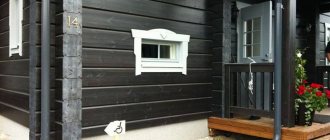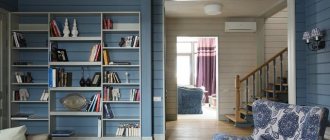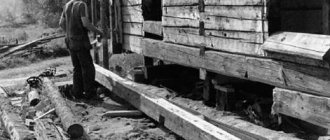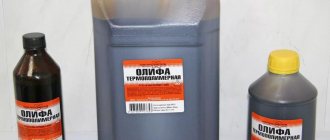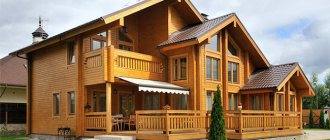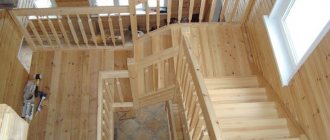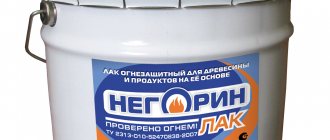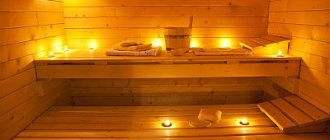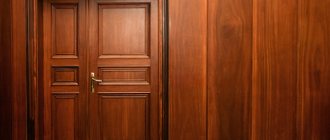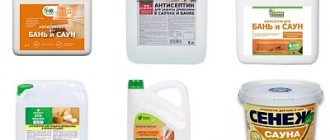I am glad to welcome my reader again!
Today we’ll talk about how to paint a log house? In general, I would say this: paint it a different color or preserve the original texture of the log house. Even if in some places with areas darkened by time and other external natural defects, but preserved in an authentic form. The topic is: how to paint the outside of a bathhouse frame and be satisfied with your work for many years?
Just in case, be mentally prepared for the fact that after painting you will not see exactly what you saw on the salesperson’s display board in the store. Somewhere the shade is not the same, roughness is possible, and the paint consumption, as a rule, exceeds what was promised. Let me reassure newcomers - this is a common reaction.
They paint ideally only in television advertisements... remember, they will run a brush or roller over the wall and immediately get a beautiful solid color. But this is the merit of the cameramen, not the paint manufacturers or plasterers. And in life, there are always “pleasant” nuances.
Design styles
Classic involves the use of white, cream, beige and light shades.
It is characterized by symmetry, precise forms, correct geometry and architecture. The interior is furnished with solid furniture and massive decorative elements. You will see paintings on the walls and voluminous vases on the floor, heavy curtains, lambrequins and draperies on the windows. The bedroom and living room are decorated in this style. It is desirable that the rooms have high ceilings, otherwise heavy curtains with draperies or lambrequins will make the space heavier and smaller. Classic style will make the room festive, romantic and luxurious.
Empire style is distinguished by red and bright, white and cream colors. Here you will see a lot of gilding and various decorations. To decorate this style, tablecloths, furniture covers and velvet curtains with embroidery, curls or drapery are used. To equip this design of a log house, heavy double doors and large furniture are installed. It is suitable for furnishing spacious rooms, such as a living room or dining room.
Art Deco emphasizes strict geometry and patterns. When decorating, geometric patterns and ornaments, stepped shapes and discreet stucco molding, wide lines and streamlined curves are used. Here you will not find bright colors and elements of romanticism. This style is characterized by halftones and predominantly dark colors, among which brown and beige, black and purple, and green are often used.
You can play on the contrast of black and white, black and purple, black and green. This style is distinguished by luxury and chic. Expensive materials are often used, including rare woods, silver, ivory, crocodile skin, etc. Art Deco is suitable for rooms with high ceilings.
Modern is a light, soft and sophisticated style that is suitable for a comfortable stay. Here they use light tones and muted colors, natural colors, smooth and flowing lines. You can see arches instead of doors, nature-themed wall paintings, light curtains and round tables.
Due to its closeness to naturalness and the use of natural motifs, modernism is perfect for decorating the interior of a log house. And since it encourages relaxation and creates a comfortable and cozy environment, a bedroom, a guest room, or a living room with a fireplace are decorated in this style.
High-tech is a modern and practical style that allows the use of open communication pipes. This simplifies finishing, but does not provide complete safety in a wooden house, as experts advise covering pipes and electrical wiring. When decorating this style, glass and metal, synthetic materials, sliding doors and transformable furniture are used.
Here you can often find panoramic windows, smooth and even surfaces, an effective combination of space and light. The main colors used are grey, metallic and silver, black and white. Small rooms are decorated in this style, as it allows you to save space and functionally distribute the space in the room. This is an attic, an office or a kitchen.
Baths with an unusual roof
When designing a bathhouse, one of the most important places is the choice of roofing structure. Traditional single-pitched, hipped and gable roofs occupy a leading position. The choice of a more original roof is often determined by saving space, availability or, conversely, strict financial savings and the specific architectural style of the remaining buildings on the site.
Article on the topic: Is it possible to collect stool in the evening and submit it in the morning?
If you plan to place a recreation room upstairs, several more complex types of roofing are suitable:
- Attic;
- Multi-pincer;
- Hip.
For very small baths, vaulted, pyramidal and domed roofs, trimmed with flexible tiles, are used.
Another way to protect a sauna stove from negative influences
You don’t have to think about how to paint an iron stove in a bathhouse, since not only paint can protect it. The method of metal bluing, which involves creating a chemical reaction, is widely used.
First the surface must be cleaned. To do this, use a 5% sulfuric acid solution, which should be applied with a brush. Then the laundry soap is diluted in water in a ratio of 50 g per 1 liter. This solution must be used to wash off the previously applied sulfuric acid. Next, the oven is heated to 150-180°C and treated with caustic soda diluted in water in a ratio of 50 ml per 1 liter. The composition should be applied only by spraying to avoid splashing.
Conclusion
In order for the stove to serve for a long time, it must be well treated, and for this you should make the right choice of what to paint the stove in the bathhouse with. The solution to this issue should be taken with full responsibility and there is no need to save money, because the stove is the main component of the bathhouse.
Paints and varnishes for wood
So, it is possible to protect the wood both outside and inside the wave using an antiseptic followed by applying a layer of varnish. Depending on the quality of the wood itself, you should choose transparent or covering compounds of alkyd or acrylate origin.
For example, there is no point in hiding the beauty of the design of expensive wood under a layer of color. Therefore, for materials such as rounded logs, laminated veneer lumber or timber made from rare wood species, colorless protective impregnations and the same varnish are used. Maximum - you can use glazing compounds that can only emphasize the texture.
In all other cases, you can choose from a large assortment:
- oil paints, the price per square meter of which is one of the lowest among paint and varnish compositions. But they have a drawback - they dry for a long time, while they can protect the tree for up to 5 years, but after 2-3 seasons they lose their presentability, freshness and gloss;
- acrylic and acrylate compositions that have greater durability - up to 10 years or more, depending on operating conditions;
- varnishes, which, thanks to their transparent structure, allow the natural beauty of wood to be emphasized as beneficially as possible. Both colorless and tinted types are used.
Especially popular when processing wood are acrylic-based varnishes that have:
- elasticity, due to which the integrity of the coating is maintained even during deformation processes in the wood;
- vapor permeability, which allows you to preserve this unique property for wood and thus ensure the creation of an ideal microclimate in the room;
- service life equal to 7-10 years.
It should be noted that acrylic paints on wood for exterior use perfectly retain their presentable appearance almost throughout their entire service life. They are highly resistant to moisture and, accordingly, to mold and fungi, and even tolerate intense ultraviolet radiation.
When choosing a paint, it is important to know that acrylic paints, although “closest relatives” of alkyd paints, have different compositions. In the first case, concentrated pure compounds are used, and in the second, combined compounds containing latex, styrene or vinyl components
Painting the outside of a log house: stages of the process
Protective and decorative painting of a house made of rounded logs on the outside is the key to its long-term preservation without loss of visual appeal. Typically, processing is divided into several stages:
- Antiseptic
. Impregnation of the facade with water- or oil-based antiseptics and fire retardants disinfects the wood and prevents new insects and microorganisms from appearing (1 to 2 passes are performed). It is convenient to apply the antiseptic through a spray bottle, so a respirator and safety glasses at this stage are not superfluous. Further procedures begin after the composition has completely dried.
- Primer
. The purpose of the treatment is that the composition prepares the surface for final painting. The primer prevents tree resin from escaping (in knots) and staining the paint.
The paint color is chosen taking into account the style featuresSource gomabygg.com
- Adhesive primer
(acrylic or oil, optional). The impregnating composition improves the adhesion of the base paint to the wooden wall and reduces paint consumption. Avoid getting dirt and dust on the drying primer.
- Cover paint
. The main paint for a log house, the final layer that decorates and protects the walls. The ideal option is acrylic paint, applied in a thin layer sequentially in three steps, using a brush or roller.
Wall material for painting
Brick walls can be coated with polyurethane varnish
Any paint will last longer if the surface is properly prepared. Brick and concrete are cleaned of old deposits, cracks and holes are repaired, and primed to enhance the adhesion of the composition to the surface.
Wooden walls are cleaned of debris and dust, sanded with sandpaper, cleaned well with a brush and also treated with a primer.
- For bricks, a universal polyurethane varnish with suitable characteristics is used. It is diluted with organic diluents, which work well in open spaces. The paints used are acrylic materials with the addition of silicone, as well as latex compounds. The latter type is highly expensive, but it all depends on the desire of the owner.
- The timber is initially treated with an antiseptic; you can use a separate product or a combined one. Repairing a timber structure is expensive, so it is better to immediately coat it with an antiseptic and a product that increases combustion resistance. Paint is applied on top.
- To paint the exterior of a bathhouse, use materials that are used to treat timber walls. The chopped wall has log ends that need to be impregnated with appropriate products. The ultimate goal is sealing. To do this, take lime and drying oil, mix wax and paraffin, melt bitumen, combine tree resin and chalk.
- Stones made of aerated concrete, foam concrete, and slag concrete have many pores on the surface, and therefore require plaster. To treat such an area, paints are used that are used for concrete and brick walls. They use oil and pentaphthalic paints that resist rain and temperature changes in winter.
- Frame structures are erected on a wooden frame, inside of which insulation is installed, and the outside is covered with boards made of boards. The result is a wooden surface that must be protected with breathable films that simultaneously protect against water and snow. If you cover a wall with clapboard, you need to use acrylic, latex and silicone compounds.
Sometimes the outer walls of a log house are left uncoated, in the belief that there is no need to spoil the environmentally friendly material by applying films and impregnations. Such a log house easily absorbs and conducts moisture, and quickly releases it. Structures last 5 to 7 years less than with painted vertical surfaces. The walls in them quickly become a fire hazard due to increased dryness.
How to properly treat the outside of a log house
For the first time, the log house is treated with antiseptics inside and outside immediately after assembly. Pay special attention to the treatment of the ends and logs in contact with the foundation. Antiseptics are applied in two layers; Primary treatment should not be carried out at temperatures below 10-12 degrees!; The next treatment is done after the log has completely dried and the frame has shrunk. This takes 6-12 months. This finishing involves the final complex and multi-layer processing of the house, which will provide protection for the log for a long time.
It is important to apply antiseptics to a dry and clean wood surface!; Before processing, the logs are sanded to remove the top layer in which fungus and microbes have accumulated during shrinkage. It will remove log defects and level the surface
Sanding wooden walls is a must for an old house, as it is important to completely remove the previous coating;
Neomid Biocolor Aqua for painting the inside of the house
For interior painting of a log house, Biocolor Aqua from Neomid is perfect. This is a glazing acrylic composition that has not only decorative properties, but also protective ones. The paint penetrates deeply into the wood of the log house, beautifully highlighting its structure. After painting, a semi-matte, translucent layer is formed on the surface. It protects the frame from fading, moisture and cracking. Also, in the future, insects, molds, and fungi will not appear on the walls of the log house. It is important that the aroma of the wood is preserved; the composition itself has practically no odor. Biocolor Aqua is also an environmentally friendly and safe product. There are 7 primary colors in the paint arsenal. If desired, you can tint it with special pastes.
Types of antiseptic impregnations
We should start the review with washable wood preservatives. They are made on an alkyd-alcohol base, which also includes metal salts. But, as the name suggests, such products are washed away. That is, it is useless to use such an antiseptic when treating the outer sides of walls - after a short time the composition will be removed from the structure. But internal processing can be done using this impregnation, since it is harmless to human health.
The opposite of the remedy described above is a hard-to-wash antiseptic. This is a product based on a combination of synthetic and vegetable oil. This type of painting of a log house can be applied to both external and internal walls. Hard-to-wash-out impregnations remain resistant to precipitation and fully meet environmental safety requirements.
Now I turn to modern materials
I will talk about those that are intended specifically for wooden buildings.
Belinka
The Belinka brand has long proven itself well. The range includes not only paints, but also varnishes, various impregnations, and glazing compounds. The range of shades of varnish and paint is very colorful, allowing you to preserve the texture of the wood, emphasizing it with a decorative background. Belinka polyacrylate paints create a film on the surface of wood that, on the one hand, has water-repellent properties and, on the other, is vapor-permeable.
Tex
Professionals speak positively about the Russian manufacturer Tex. In addition to paint, the company has several types of antiseptics, including ground and glaze, drying oils, fire retardant impregnations and wax-based compounds.
Tikkurila
If finances allow, contact the Tikkurila brand, respected in Russia. The paints of this Finnish manufacturer have been tested in the harsh conditions of the northern climate. They contain components containing various additives that prevent the formation of rot, moisture absorption, and protect against ultraviolet radiation.
You can choose from acrylate paint called Pica-Techo, oil Techo, polyacrylate, Ultra-Classic. This brand, in addition to its relatively high price, has another drawback - names that are difficult to remember. Here they are.
And of course, the Finnish company has all EU certificates confirming environmental friendliness.
In general, recommendations for painting a log bathhouse boil down to what needs to be taken into account:
- Firstly: the better (that is, more famous) the manufacturer, the better and more durable its primer and topcoats;
- Secondly: use special-purpose compounds, in our case, intended for external wooden walls. If you find among well-known manufacturers special paints for facades made of rounded logs, it will be even better, but, unfortunately, I don’t know such paints.
Saikos
Finally, let’s touch on the German manufacturer SAICOS. The catchphrase - “True German quality” is very relevant to this day. The main feature of this product is that the base is only natural oils and waxes. The conclusions here are simple: such wood impregnation will preserve your structure for many, many years. In a word - I recommend it. I think that professionals will understand me...
Painting a wooden frame
Purpose and features
Modern paints not only effectively protect, but also decorate the facade of a wooden house.
Wood is an organic “living” material that is subject to many destructive influences.
The most dangerous factors are:
- Moisture. The presence of moisture is a sufficient condition for the development of microorganisms and bacteria, which cause rotting of organic matter and disintegration of the material in a short time. Also, moisture has an extremely negative effect on the decorative qualities of wood and its performance characteristics;
- Fungi and bacteria. Wood is a favorite nutrient substrate for many types of mushrooms, which quickly digest and turn even large structures into dust. Bacteria cause decay and decay processes, and also release various waste products (this also applies to fungi), which also spoil and decompose the material;
- Solar radiation. Ultraviolet and infrared radiation destroys many of the compounds that make up wood, causing changes in color and surface properties;
- Insects. All kinds of wood-boring beetles, larvae, worms and other herbivorous organisms eat the material and destroy its structure, and also spoil the appearance of logs or beams.
Wood quickly deteriorates under the influence of the external environment and microflora.
In addition, there is another danger: during the drying process, complex processes occur in wooden parts, which lead to the appearance of cracks and changes in the geometry of the products. The most obvious effect is the uneven movement of moisture in the longitudinal and transverse direction of the fibers.
Uneven drying causes cracks to appear.
The fact is that moisture moves much more actively along the fibers than across, and as a result, the ends of the logs or beams dry faster than the side surface
Stresses arise inside the parts and they begin to crack, so it is quite important to determine how to paint the ends of the frame and slow down, or rather even out, the drying process of the product
To equalize the rate of moisture evaporation, a better way than painting the ends of the frame has not yet been invented.
It should be remembered that you should not paint the house with topcoat paint for the first year or two, since it must finally settle down and adapt to the humidity and dry out. But it is better to process the ends immediately, as this will protect the finished facade from cracks. For these purposes, use lime, water-based paint or a special composition for processing the ends.
Typically processing occurs in several stages:
- Impregnation of the material with antiseptics and fire retardants destroys existing microorganisms and prevents the appearance of new ones;
- Anti-tar primer allows you to avoid the release of resins from knots and the appearance of stains on the paint;
- Impregnating adhesive primer reduces paint consumption and increases its adhesion to the base;
- The finishing finishing paint decorates and protects the material from the external environment.
Materials
Choosing paint.
Various compositions can be used to paint the facade:
- Oil paints. These materials are distinguished by their low price and fairly high protective ability, however, they are not durable and impermeable to steam, which makes their use as a coating for residential buildings undesirable. The material also has a toxic composition;
- Alkyd paints. They form a good protective film, serve for a long time, but are also very toxic and not very durable;
- Acrylic facade paints for wood. The highest quality option in all respects: the paint does not contain solvents or other toxins, is strong and durable, very beautiful, vapor-permeable and does not lose its brightness over time;
- Aqualacs based on acrylate resins and dispersions. Also safe and beneficial from the point of view of external beauty, but less durable and durable than paints;
- Glazing impregnations, oil-waxes and transparent varnishes. They are considered the least reliable in terms of protection, but at the same time they look very good and retain the natural beauty and texture of the material.
Painting the outside of the bathhouse with acrylic paint.
You should not use materials intended for other purposes - fire-retardant paints for metal Polistil or electrically conductive paint Zinga, despite their quality, will not give the desired result.
Important points when painting a house
Two main factors affecting the quality of painting are weather conditions and wood moisture. It’s hard to say at what temperature you can paint the outside of a wooden house. The main thing is that the weather is dry and windless. Do not paint during or after rain, or in the scorching sun.
Wood moisture content during painting should be within 20%. And this begs the question: when to paint a house made of profiled timber after construction if lumber of natural moisture was purchased? There is only one option - we paint the timber only after it has completely dried.
Before painting the outside of a log house or before painting a log bathhouse, coat the ends of the logs with water-based paint or lime. It is advisable to do this immediately after the construction of the log house, even before sanding work, in order to prevent the logs from drying out. After sanding the house, the ends should also be painted at least 3-4 times.
Many home builders are interested in the question: how to paint the outside of a tall house with your own hands? To do this, you can take a stepladder or special sliding stairs. If the second floor and the gable of the house are located at a considerable height, you can build the scaffolding yourself, using strong and dry boards with a cross-section of at least 40 mm.
What is better to paint the outside of a wooden house with a brush or a spray gun? The paint applies more evenly when applied using a spray gun. However, if you do not have the skills to use a spray gun, it is better to paint with a wide natural or mixed brush with dense padding.
Table of end finishing products
| Name | Manufacturer | Properties |
| Senezh Tor | Russia | Good protection due to the penetration of the material several cm deep into the log house. It has the ability to allow air to pass through, but does not release moisture from the material. This means that the log house will dry as naturally as possible. Environmentally friendly product |
| Neomid Thor Plus | Russia | Forms a thin film on the surface of the log, which is water-repellent. Protects wood from cracks and putrefactive processes |
| Biotor | Russia | Thanks to the solution, the log will deform significantly less, since the product protects against dried cracks |
How to paint a log house?
The lower crowns are treated with waste oil.
Let's divide the materials into two types: folk and modern. First, I will give a few folk recipes. What if someone wants...
Waste machine or transformer oil
Yes, the smell is not very good, but it will disappear after a while, but the impregnation will remain and will create a waterproof layer. Although dust sticks to it “freshly”. Apply the oil with a rough brush and rub in thoroughly.
Turpentine and wax
Mix in equal proportions. In addition to protecting against moisture, this composition provides good protection against wood insects and gives the walls of the log house a certain gloss of “well-kept antiquity.” Particularly suitable for painting baths “in years”.
Oak bark decoction
A nice darkened background, however, the wood pattern is clearly visible through it. An old and forgotten method.
It is better not to make coloring compositions from onion broth (these are not eggs for Easter). Yes, they give the logs a pleasant shade, but as an “undesirable bonus” they have a smell that attracts insects.
My opinion is that you shouldn’t get carried away with environmental products. In a number of ways, it is no longer easy for them to compete with the products of the chemical industry. But if you are a principled supporter of natural raw materials, then, without a doubt, go ahead!
Services of professional finishers
offers its services for painting and varnishing the facade of a wooden house. We have specialized in finishing timber and log houses for more than ten years. The qualified craftsmen of our company have extensive experience working with wood.
We use certified paints and varnishes from well-known manufacturers, which are of high quality and safety. We are ready to perform any amount of work, from local painting to turnkey home finishing.
You can leave your requests in any convenient way using the coordinates in the “Contacts” section.
Calculate the cost of painting and insulating your home right now
Do you have accurate measurements of the house?
I measured it myself. I have a house design. Measurers came. I want to call a measurer.
By clicking on the button, you consent to the processing of personal data
Stages of work on finishing the base - features and technologies
What is better for insulating a wooden house: foam or caulk?
PPU for thermal insulation of a wooden house
On the peculiarities of using oil impregnations indoors
Color palette
Color palette
I decided to touch on this topic first, since everyone is interested in what color the façade of a home can be painted. The choice of color depends on your taste preferences, as well as on the color of the roof of a wooden house.
You can choose a color according to standards not only for houses made of laminated veneer lumber or logs, but also for brick or concrete houses. So:
- Light colors can be combined with dark ones. For example, for a dark roof, light coffee and beige shades of the facade are used
- If your private house is surrounded by greenery, then you can safely improvise with the design. The color can be rich and bright, but even here do not forget about the combination of details. You shouldn't paint your house green if there is a lot of vegetation around it.
- A painted house can stand out thanks to small details, that is, against the background of a light facade, contrasting window frames, cornices and slopes will look very nice. By the way, all additional elements, such as drainpipes, are also matched to the color of the overall design
- The style in which you plan to decorate the facade will play a huge role. Therefore, stop your choice on those shades that accompany this style. Sample catalogs from manufacturers will help you choose a color.
The color of the roof should be combined with the design of the facade, so if you have the opportunity, then immediately opt for more compatible finishing materials. As a small example, here are some possible colors:
- Bright red and soft yellow
- Rich gray and canary
- Cream color or cool yellow harmonizes perfectly with dark blue
A small table of shade combinations that will help you successfully paint your house:
| Color of the walls below, roofs on the right | Blue | Dark blue | Dark green | Brown | Chocolate | Orange | Red | Cherry | Dark grey |
| Light blue | 4 | 5 | 3 | 5 | 5 | 2 | 3 | 5 | 5 |
| Turquoise | 2 | 2 | 2 | 5 | 2 | 2 | 2 | 4 | 4 |
| Light green | 3 | 3 | 3 | 5 | 5 | 3 | 5 | 4 | 5 |
| Yellow | 5 | 5 | 5 | 4 | 5 | 5 | 5 | 5 | 5 |
| Beige | 5 | 5 | 5 | 4 | 5 | 5 | 5 | 5 | 5 |
| Pink | 4 | 5 | 5 | 3 | 5 | 2 | 2 | 5 | 5 |
| Pearl gray | 4 | 4 | 2 | 4 | 3 | 3 | 4 | 5 | 4 |
| White | 5 | 5 | 5 | 5 | 5 | 5 | 5 | 5 | 5 |
The table is very simple to decipher: 5 is excellent, and 2 is bad. Give due consideration to the choice of color, since in the future the facade design will serve you for many years.
Requirements for paints
After drying, the compositions have different textures and colors. Previously, the outer walls of a chopped bathhouse were covered with oil paint, but under such a layer the wood does not breathe, since the film does not allow steam to pass through.
The paint layer should allow steam to escape so that mold and microorganisms do not develop under it. The surface should not fade or become dull over time.
Vapor permeability
This is one of the important parameters when choosing paint. The walls of the bathhouse conduct steam, which comes out from the inside, but it does not enter the air if the colorful film does not release it. As a result, the wall begins to rot, which gradually covers larger and larger areas.
The indicator that people pay attention to indicates the amount of moisture that a square of film can let through per day.
The basis
Impregnations ensure the safety of wood under a layer of paint
The base is acrylic, mineral particles, pigments; synthetic and natural latex are added to them. The solvent is organic matter, water, emulsion, oil. High-quality paints with a vapor-permeable effect are produced on the basis of plyolethyl resins. Enamels form an impenetrable film for steam.
Waterproof
The painted side should not absorb water from the outside, and the ability of the surface to accumulate dirt is also discouraged. For characterization, the moisture absorption coefficient of the paint is used.
Protection of decorative qualities
Paint and varnish are characterized by abrasion rates. The higher it is, the longer the layer will last in its original form. The smoothness of the surface is important so that dirt is easily washed off by rain from the surface. Decorative properties may change due to the action of wind and temperature changes, which must be taken into account when choosing.
UV resistance
The pigments in the composition change brightness under the influence of the sun, so protective components are added to the paints. The rays dry out the walls, kill microorganisms, but burn out the color of the paint. Ultraviolet leads to overdrying of the top layer of untreated wood and destroys it. The most resistant are polysilicon, acrylic, and silicone materials.
Why and from what wood needs to be protected
The outer layer of wood, devoid of bark, is completely defenseless both from the destructive effects of wind and sudden fluctuations in humidity, and from insect pests. The risk increases if the house is located in a rural or wooded area. This is explained as follows:
- As a result of complete cleaning of the wood surface from bark, it is easier for wood-boring beetles to access it.
- Under the influence of constantly changing relative humidity levels throughout the year, mold appears on wooden houses over time (usually in inconspicuous places, where it is most difficult to remove).
- Moisture stains remaining on an unprotected surface provoke the development of fungal diseases on the wood.
- With constant weathering, the surface of the building changes its natural color, becoming dull brown, which is why a wooden house loses its aesthetic appearance.
Based on this, when a wooden house is ready, it should be subjected to surface sanding, antiseptic treatment, and then painting.
Painting logs on the outside has a number of advantages:
- paint and varnish materials prevent destruction, dampness and rotting;
- antiseptic treatment protects the log house from pests, fungal mold and corrosion;
- Exterior painting provides an opportunity to create a façade that fits perfectly into the architecture of the house and landscape solutions.
Compositions
Many people will immediately answer that there is no need to treat it inside at all, because there is “chemistry” everywhere, and it is always harmful, especially in a bathhouse. If we understand by “chemistry” artificially obtained organic compounds, then yes, many of them will not bring anything good to living organisms if they get inside. But, excuse me, we ourselves also consist of organic compounds, and we eat them too. You just don't have to ask the question like that.
A steam room is a place where elevated temperatures make various substances more volatile. These are the smells of herbs, and resins in wood, and phenols in mineral wool... In general, if you smell the smell, it means something has warmed up and is “phoning.” It’s bad when paint or varnish, or PVC, or mineral wool, or sulfides in stones begin to “sink.” Therefore, they try not to put plastic in the steam room; for insulation they use only those heat insulators that do not release binding substances when heated (if mineral wool, then with a mark on the packaging “for saunas and baths”)...
IMPORTANT! They also refuse to use varnishes and paints based on organic solvents.
But the modern paint and varnish industry has already taken a technological step towards greater humanity and environmental friendliness. Now there are water-based varnishes and paints that practically do not smell when applied, and after drying they form a fairly durable polymer that does not smell of anything at all.
Therefore, the Finns, knowing perfectly well what temperature conditions they have in their steam rooms, make and sell compositions that have been tested and are considered safe. These are water-based acrylic coatings. Or they are impregnations made from completely safe oils - linseed, paraffin...
However, don’t even let the paint harm your health with its smell, it reacts quite poorly to moisture, tends to peel off, hang in rags... Therefore, if you paint the steam room in a bathhouse with anything, then only with special compounds that are suitable for bathrooms (also written on the packaging ). Such coatings are waterproof.
Lucky
After all, natural wood in a steam room is such a built-in standard. Therefore, somehow the thought does not arise about paint that will hide the texture of the wood. And there is no need - now you can tint the varnish with any color - be it green or pink.
Let’s think for a second about why we should even look for varnish for the steam room in the bathhouse. Wood that is heated and moistened undergoes deformation - it gains moisture, swells, then contracts in volume, and often cracks after this. And if it fails to dry properly, fungi and bacteria take advantage of this, converting the cellulose into rot.
So, coatings such as varnish are not so much for beauty, but for protection - from cracks and deformations, from mold.
You can protect the floor by using waterproof yacht varnish. Even though it contains polyurethane or urethane. The thing is that the temperature on the floor in the sauna is low - the Finns are required to have a 5-10 cm gap under the door to the steam room.
In a Russian steam room, if you don’t make special heated floors, it’s also not that high, it’s unlikely to be higher than 30 degrees. Therefore, yacht varnish will not hurt here either.
Waterproof, highly abrasion resistant varnish will make the floor more durable. Just don’t allow a problem like the one in the video below.
The walls can also be varnished, but this time it is safer.
ATTENTION! This can be any acrylic varnish that clearly states that it is intended for sauna walls.
Such varnishes are available from different manufacturers - both Russian and foreign. Teknos, Belinka, Tikkurila, Dulux have them, as well as ours - Neomid, Senezha, Rogneda, etc. If there is a certificate, it means the product is good.
Oils
When they talk about “oil for a steam room in a bath,” they mean impregnation for wood, but not drying oil. Compositions have long been developed that do not smell like drying oil. In particular, there is no smell from paraffin oil.
Treatment of the bathhouse inside the steam room with oils is usually limited to covering the shelves with them. This is done because it is the safest way for humans to protect the tree.
On sale you can find both liquid oil compositions and more solid varieties containing, in addition to oil, also beeswax. The latter are even better, considering that wood has been waxed for a long time, and not only for a beautiful shine, but also to increase its service life and protect it from all kinds of pests.
Brand overview
When choosing varnishes, enamels and paints for painting baths and saunas, you should give preference to specialized lines, since the creators of such products take into account all the technical features and characteristics of wet rooms. The Finnish company Tikkurila is considered the absolute market leader in this segment. Among the most popular compositions from this manufacturer are the following.
- Supi Saunasuoja is a high-quality impregnation for interior coatings based on an aqueous solution with acrylic. Can be used in rooms where the temperature exceeds 100 degrees. Available in a condition suitable for tinting.
- Supi Laudesuoja – oil enamel, used for painting shelves in saunas.
- Supi Saunavaha - this varnish is considered a universal product intended for all types of bath surfaces.
Users note that imported formulations are very effective, especially when it comes to Finnish manufacturers. They have only one drawback - the high price. That is why some bathhouse owners prefer Russian manufacturers who offer cheaper lines. Here are a few brands that are in demand when painting bathhouses.
- “Senezh Sauna” is an acrylate antiseptic used to protect wood lining in bathhouses. Includes a fungicidal component and has no chemical odor.
- Neomid 200 is an effective coloring agent that includes antiseptic components. The composition is in demand when processing shelves, benches and other wood coverings in saunas and baths.
- Neomid Sauna is a translucent acrylic-based varnish, used for impregnation of wooden lining in steam rooms and other rooms with high humidity.
Import substitution of paints for wooden structures in 2015
In 2022, all imported wood paints purchased for dollars and euros have become unreasonably expensive.
The price-quality ratio of imported paints has become unreasonably high in relation to Russian paints and varnishes.
Therefore, we advise you to opt for Russian-made impregnations and paints in 2022.
Photo: Healthy Home wood protection product will help provide reliable protection against pests for walls, floor beams and rafters of a wooden frame.
Photo: the color scheme of the “Healthy Home” composition has a fairly wide range, from light tones to the darkest color.
Photo: decorative protective paint and varnish composition of the Neomid BioColor Ultra brand has enhanced protection for log wood and is a high-quality composition intended for wooden log houses. There are 10 primary colors to choose from, ranging from clear formulations to dark protective formulations.
Manufacturers and product prices
Bath paint is produced by domestic and foreign manufacturers. Its price depends on the material used and the quantity in the jar.
Belinka
The manufacturer's product range consists of paints, glazing compounds, varnishes, and impregnations. They have a wide range of colors, which allows you to bring any design idea to life. When using materials, the structure of the wood is preserved. Belinka produces polyacrylate paints that have water-repellent and vapor-permeable properties.
Tex
Paint from the Russian manufacturer Tex has protective qualities, which guarantees an increase in service life. The company produces soil and glaze antiseptics, drying oils, wax compositions, and fire-retardant impregnation. This allows you to choose an acceptable option for painting the bathhouse.
Tikkurila
The compositions are produced by a Finnish company in accordance with innovative developments. After production, the compositions were tested in harsh climatic conditions. The materials are developed using special components that protect the coating from ultraviolet rays and the wall from excessive absorption of moisture and rot.
The range consists of acrylate, oil and polyacrylate compounds. The paints are certified by the European Union, which ensures their environmental friendliness. The paint has a high cost, which is explained by its excellent technical characteristics. Before applying the composition, areas that cannot be painted are covered.
Saikos
The compositions of the German manufacturer are developed on the basis of natural oils and waxes. This ensures the preservation of the structure for many years.
How to paint the outside of an old wooden house using old paint
There is only one recommendation - if the old layer holds well and is not covered with cracks and there are no areas of film peeling visible on it, then you need to use the type of paint that was used previously. You can confidently apply alkyd paint over oil paint - they combine well. But acrylic ones are not suitable here, although some manufacturers allow such contact.
If you do not know what type of paint was previously used to paint the house, it can be determined by the appearance of the old coating. If the old coating has a leathery surface and is slightly chalked, then most likely the house was previously painted with acrylic paint. Acrylic paint cracks along the grain of the wood.
If you can roll a small piece of paint into a tube, then most likely you are dealing with acrylic paint. If a piece of paint cracks when rolled up, it is most likely oil paint. Oil paint develops net cracking as it wears.
If the surface is covered with a glossy film of glazing antiseptic, then the surface can be repainted with the same antiseptic or with oil or alkyd paint. To repaint with acrylic paint, you will need to remove all the old antiseptic film down to the wood.
Mistakes when painting a house yourself
Many people who decide to paint a wooden house themselves are perplexed as to why the coating turned out unsightly, and after a short time it peeled off and they have to repaint it again. Some blame it all on low-quality dye, but even the best paint cannot produce high-quality and beautiful paint when non-professionals take on the job.
Home builders often make many mistakes:
- due attention is not paid to home preparation,
- Grinding is carried out incorrectly,
- the painting process is disrupted,
- the temperature regime is not maintained during operation,
- wet lumber is painted,
- materials that are incompatible with each other are selected.
All these errors affect the final result, which causes confusion.
Paint selection
If you follow the recommendations from professionals, compositions intended for painting wooden surfaces should have the following properties:
- Good permeability into wood when it comes to antiseptic coatings. The annotations on the container contain information about how deeply this component acts. It can be considered good if it protects the wood by 1/3.
- Environmentally friendly. Do not forget about the true purpose of a wooden house - heavy chemicals have no place here. However, the market is now so crowded with all kinds of products that even the price does not help to distinguish the quality. Here you should be guided by the reputation of the manufacturer. Today, Russian and German-made products have proven themselves well. The main thing is that there is a label on the packaging indicating “green” safety.
- External attractiveness. This is achieved by glossy components - varnish, oil and acrylic compounds.
- The composition of the wood coating must certainly include fire retardants - fire-fighting chemicals. This is the main safety for wooden house construction.
Correct coloring
Before painting the outside of an old log house, you need to perform several steps to prepare the surface before the painting process:
- Clean the wood from dust and dirt. You can even wash it, but don’t get carried away with the hose, but use a washing vacuum cleaner, which will do two things – wash and dry.
- Then you need to start sanding. For this, a hand machine or sandpaper is used. You'll have to work hard with the last option. However, by performing such actions before applying the composition, you can be sure that the paint or impregnation will lie smoothly.
- Before decorative layers, the log house is covered with all kinds of protection - fire-, bio- and moisture-resistant compounds. Exactly in that order. Moreover, each layer is applied in two approaches and after that the house is left alone for a couple of weeks so that the layers are evenly absorbed and distributed in the wood.
Thus, the question of how to paint the outside of the log house is resolved. On the inside, as a rule, other decorations other than paint are used.
Work order
As it has already become clear, the main goal when choosing a product for painting the outside of a log house is to protect it from various types of influence
But to ensure 100% protection, it is not enough to buy a high-quality coating; it is also important to carry out the painting work correctly. Here are some valuable tips that should help
It's better to paint it yourself. This will not only save the family budget, but will also provide benefits in paint quality.
It is important for the construction team to deliver a beautiful object visually, so they will not worry about the thorough processing of each element. Namely, small unpainted places can later cause the appearance of rot, fungus and other troubles.
Proper preparation of a log house for painting. Before painting, it is worth preparing the log house for this stage of finishing work. First, the surface of the wood is cleaned of dust and dirt. It is best to wash the wood and then let it dry. It wouldn't hurt to do some sanding. After this, several layers are applied to the surface of the wood:
- primer;
- antiseptic;
- fire protection agent.
Figure 5 – Painting a wooden frame with sealant treatment
It is best to paint the ends of the logs with lime or a similar composition. This is worth doing so that steam can move along the log along the fibers, as when a tree grows. This is much better than across.
There is no need to leave gaps when painting. To do this, add a little colored tint to the colorless antiseptic. After applying it, let it dry thoroughly. This way you can avoid the presence of even the smallest unpainted areas, which can subsequently lead to quite serious problems.
In conclusion, it should be advised that when choosing, you should focus on the most beautiful options, because a bathhouse should please not only the soul, but the eye.

